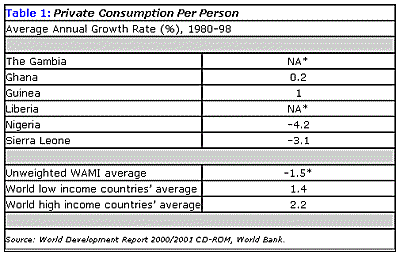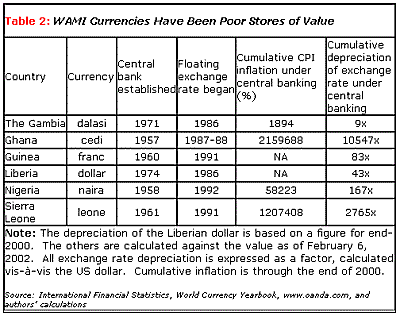The transition to monetary union will be managed by the West African Monetary Institute (WAMI), which received its mandate on December 15, 2000 and began operations in January 2001. Its responsibilities are voluminous. These include harmonizing laws and regulations in the member countries, fostering cooperation between the members' central banks, establishing an appropriate interim exchange-rate mechanism, conducting and disseminating research on monetary policy issues, determining policies for convergence, promoting the development of a regional payments system, and educating the public about the features and value of the new currency.
The monetary policy rules of the future West African Central Bank, however, are anybody's guess. Indeed, the subject of monetary policy is allotted but one sentence in the WAMI's mandate: "The Institute will pursue appropriate monetary policy to ensure price stability and sustained economic growth in these countries as part of the overall ECOWAS integration effort." It is unclear, therefore, whether the new monetary union will pursue a quantity target (i.e., the growth of a specified monetary aggregate), an inflation target, an exchange rate target, or any combination thereof.
However, meeting even this broadly defined mandate would require the WAMI and WACB to be something greater - much greater - than the sum of its parts. Not one member country has been able to produce price stability or sustained economic growth. Growth has been elusive, in large part due to the lack of a strong currency. According to the World Bank's World Development Report of 2000/2001, the average annual growth rates from 1980 to 1998 of private consumption per capita have lagged far behind the rest of the world in WAMI member countries. In the cases of Nigeria and Sierra Leone, they have been strongly negative. The data are presented in Table 1.

*There is little data available on Liberia due to the civil war which lasted from 1989 to 1996, which destroyed most of the statistical base.
The IMF estimates that production in 1996 was roughly 10 percent of the pre-war level. The Gambia's GDP growth has, conversely, been rather strong. Given Liberia's sharp decline, however, the net effect on the unweighted average of private consumption growth for WAMI countries is probably to push it lower than the -1.5 percent rate indicated.
Price stability has also been a pipe dream for these countries. Price stability can be measured in two ways: the rate of consumer price inflation - a measure of internal value - and the behavior of the exchange rate - a measure of external value. On these matters as well, the member states have had a poor record since establishing central banking. These data are presented in Table 2.

Note: The depreciation of the Liberian dollar is based on a figure for end-2000. The others are calculated against the value as of February 6, 2002. All exchange rate depreciation is expressed as a factor, calculated vis-à-vis the US dollar. Cumulative inflation is through the end of 2000. Source: International Financial Statistics, World Currency Yearbook, www.oanda.com, and authors' calculations.
A look at the data reveals that all WAMI countries have failed to issue currencies that are reliable stores of value. Admittedly, no currency is perfect; in the United States consumer prices have risen 532 percent since 1957, when the Bank of Ghana began operating, and the dollar, over that same time period, has depreciated from $35 to the current level of about $300 per troy ounce of gold. But with histories like these, why should anyone expect the currency issued by the new West African Central Bank to be any better than the cedi, the naira or the leone have been?
A plan for a successful monetary union in West Africa must take into account the experience of West African nations with central banking. Consequently, a new monetary union must be bound by rules that place monetary and exchange rate policies out of governments' reach. Tomorrow we will evaluate the feasibility of the WAMI's convergence criteria and present a plan for a successful monetary union in West Africa.
Matthew Sekerke is Research Associate at the Institute for Applied Economics and the Study of Business Enterprise at the Johns Hopkins University. He can be contacted at sekerke@jhu.edu. Cedric Muhammad is President of Black Electorate Communications and can be contacted at cedric@blackelectorate.com.